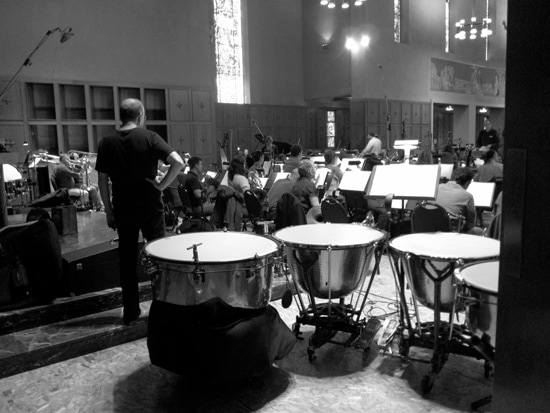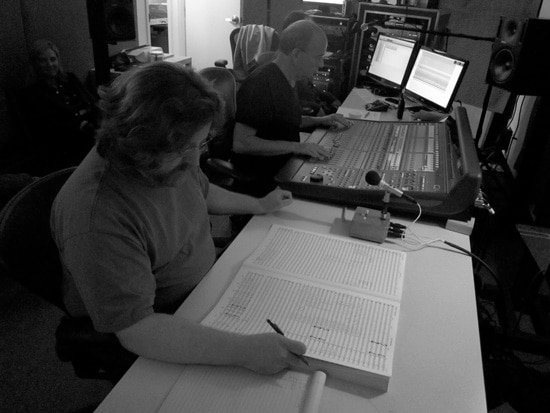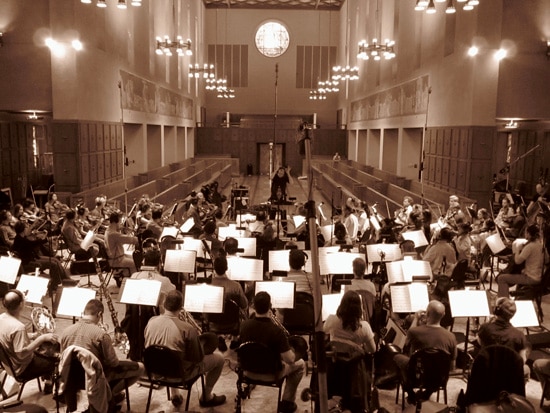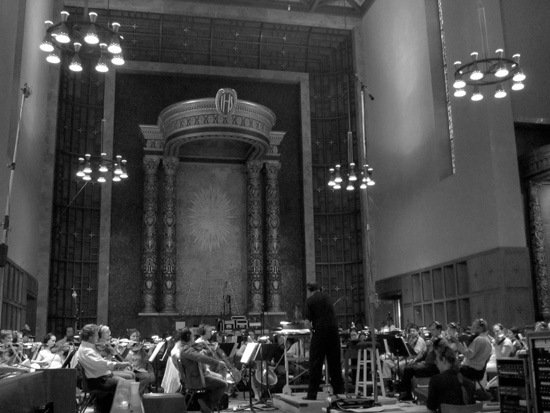The Music of Mists: an Interview with Russell Brower
The Blizzard Music section has been updated to include the soundtrack to World of Warcraft: Mists of Pandaria. When you visit the page, you’ll be able to read notes from the soundtracks’ composers, listen to song samples, and download albums and individual tracks directly through iTunes.
To provide more insight on the development of this auditory (pandaren) feast, we sat down with Senior Director of Audio Russell Brower to talk about the making of the Mists of Pandaria soundtrack and his views on the purpose of music in games. Read on for the full conversation below!
Q: The role of sound and music in games, even in our games, isn’t always clear. Is there anything you’d like to tell players about what your team does?
A (Russell Brower): I believe our players already have a great appreciation for the role of sound and music in games. A healthy portion of our players can’t imagine a Blizzard game without what we do. Sound and music aren’t always an essential part of gameplay, but Blizzard wouldn’t ship a game without them, just like we wouldn’t ship a game without great cinematics.
We’re a visual society; we take our hearing for granted unless it’s taken away from us. It’s the first sense that’s turned on in the womb, and, unless something breaks with your hearing, it’s on for the rest of your life. Marty O’Donnell, a good buddy of mine who’s my counterpart at Bungie, has a saying: “the ear does not blink.” Sound is a constant immersion tool—voiceover has to be localized, but music doesn’t, and sound effects don’t—they’re a universal language.
Also, the team strives to keep people from turning their sound off. There will always be hardcore players who’ll never have sound on; they’re in voice chat, or they need absolute focus. I feel like that’s a frontier we have yet to conquer, but also, as social gaming continues to put people in closer contact with each other, the challenge of sound to remain immersive is only gonna get tougher.
Q: Do you find that players get bothered by game sounds with any regularity? Where does that concern stem from?
A: Well, for example, we’ve had to tone down our auto-playing sounds to be less startling. We found that some people will put headphones on, and after two hours of installing, suddenly the game will go “BOOM!!” when it finishes. People started to install games with the sound off.
Q: Right! When you hear one of those thundering installation complete sounds, it's like, “ack, did a bookshelf fall over?”
A: For our Cataclysm update, 4.3, you heard horns when the update was completed—it was a bit more easy-going. Another example: a LOT of people hated Sindragosa’s constant roaring on the Wrath of the Lich King title screen. So, when we were scoping out Cataclysm, we thought, “oh, man, not another dragon update!” We actually got the World of Warcraft team to keep him mostly quiet. It was a fight, but then we saw far fewer complaints. With the MoP login screen, I’ve seen a lot of grateful comments. I’ve had a lot of people on Twitter tell me that they actually waited and listened to the entire piece of music before logging in.
Q: What instrumentation did you use for the MoP soundtrack? It sounds very different from what we’ve heard in other World of Warcraft expansions.
A: We supplemented the usual palette of sounds rather than replace it. That stemmed from a conversation I had with Chris Metzen early on; we were looking at all the gorgeous artwork and art direction of Pandaria, and he said, “the artwork is telling us we’re in a different world, a place of wonder, but one that will potentially get conquered by the Alliance and Horde.” He felt that we needed an Asian overlay, but that the soundtrack was also an opportunity to remind us that we’re still in Azeroth. We shouldn’t go so far afield that it doesn’t feel like Warcraft.
So, we kept our usual palette of epic orchestral sounds, but we added some specific Chinese instruments. One is the erhu, which is basically a Chinese fiddle; it’s got 2 strings, and an almost vocal vibrato singing quality. We also added the guzheng, which is like a harp, but it’s long and laid out flat. It’s both strummed and plucked. The third instrument was called the dizi—you know how if you pluck a blade of grass and blow on it, you get that reedy sound? Well, the Dizi has a hole in it with a membrane that vibrates, and so it sounds like a flute, but it has this very buzzy overtone. We also included one more—the pipa, which is more or less the Chinese version of the banjo. Those four instruments, along with Chinese drums, gave us the overlay we needed to have a bit of Asian feel. We also changed the orchestra’s playing style—even when we were using familiar instrumentation, we had a bit more sliding between notes at certain times. In some ways, it’s what Hollywood has told us Asian music sounds like, but some of it’s authentic. Those Chinese instruments were all played by masters.
Q: Oh, so this isn’t you guys picking up an instrument for the first time?
A: Oh, no. Luckily, in California, you can get instrument experts fairly locally. Everyone was local except for the arhu player, who we flew in from the Bay area. In China, she’s considered a major star—she actually teaches, and also plays violin. So, she’s able to play in the language of Hollywood, but also with the personality of her instrument. We would typically say to her, “ok, play it idiomatically correct this time; ok, now play it like a violin.” In editing, we got to pick and choose, because there were times when the idiomatic version was so heavily vibrato or ornamented that it might actually call too much attention to itself. It’s the role of music to support and immerse, not to say “hey, listen to me!” We’ve actually failed if the music is calling too much attention to itself.
Q: Can you elaborate on that sentiment? What do you think the role of music is in gameplay? Guiding or instructing a player, providing cues—is that something you think game music should or shouldn’t do? Where does our music influence our gameplay?
A: It depends on the game, but in our games, certainly in World of Warcraft and Diablo, the music adds to the immersion. I think in Diablo it’s a little more about mood, where we want to enhance the creepiness, until we get to the cinematics, and then we get to character development. There’s a theme for Diablo, and there’s a theme for Leah.
WoW has even more of that—there are very specific melodic devices and tone colors for Alliance and Horde, and for some of our major figures. Arthas has an arc coming from Warcraft III, where a melody was first established more than 10 years ago, and that DNA is in the song "Invincible." In fact, it’s the chorus. There are new verses, but the chorus came from 10+ years ago.
StarCraft’s a different animal in that the gameplay is so fast—it’s very strategic, but there’s a little bit more ‘twitch’ gameplay involved, so the music needs to stay out of the way. The map music is really just there to make the game cooler—where the music gets critical in StarCraft is in the cinematics. Starting with the original StarCraft, each race had a very identifiable musical signature, and that carried over to the maps and played a part in cinematics. Wings of Liberty is where we really started establishing themes for characters. While Raynor is synonymous with the part of the Terran race that listens to space-cowboy trucker music, he ended up with his own theme in Wings of Liberty. We’d started some Zerg stuff in Wings, but it’s fully developed in Heart of the Swarm, and we’ll see that happen again with Legacy of the Void for the Protoss. We established a melody for Zeratul in Wings, and that’ll carry over and get developed, too.
So, the role of music, in WoW especially, is closer to its role in a movie, in that we can convey what would take too many words to describe otherwise. When you read a book, you can get inside a character’s head and hear what they’re thinking. In a game, we really don’t have that luxury—they’d have to talk too much, and we’d have to localize it, and it’d stop gameplay. We want to stop gameplay as infrequently as we can. Music doesn’t have to be translated—people say that it can tell you how you’re supposed to feel, and I suppose that’s true sometimes, but sometimes it amplifies what’s already there.
Q: Yeah. You see a sweeping vista, and the score emphasizes the grand scale of it all.
A: All rules are meant to be broken, though, so sometimes you play against type. There’ve been moments in StarCraft where a character has done something awful, and he’s listening to opera. It’s the classic gangster-movie juxtaposition. Similarly, some of the music in StarCraft, this space game, could be considered “spaghetti western.” It’s a nice genre flip, especially for someone who’s not expecting it.
Q: There’s a track on the Mists of Pandaria soundtrack called “The Traveler’s Path,” which sounds like it contains a conlang, an invented language. Is that accurate?
A: Yes. We went to our Creative Development team, and, for certain NPC responses, they’d already begun to spin a language, and we asked them to flesh out some words in English that [Lead Quest Designer] Dave Kosak had written. It’s the story of Liu Leng, and the turtle, Shen-sin-zu, and why Liu Leng left Pandaria and came back. I was inspired by a video of Dave doing what he called “story time,” where he told the story of Liu Leng, and when I realized that part of the player experience was that you weren’t necessarily going to realize you were on a turtle until you got on a balloon and went around the island and saw his face for the first time in a mini cut-scene. So I thought, “why not write a song that tells the story of Liu Leng?”
When I was a little kid in choir, we learned a Japanese song called Sakura—it was easy for kids to learn and remember, so I wanted to find the Pandaren equivalent of that—a melody so simple that it could be an ancient folk song, one where the words could change over the centuries. In this case, Lorewalker Cho would be singing the part of Liu Leng, so we asked Creative Dev to basically translate the story, and then we went through a process of vetting it with the localization guys to make sure we weren’t inadvertently saying something offensive in Chinese or any other language.
Dave was so excited that he made a whole quest line around the song. It only happens at certain times; you go out to a little beach where Lorewalker Cho’s waiting, you sit down in front of him and he sings the song, and places all these paper boats in the water, and it’s just this gorgeous thing. Yeah, we focus on gameplay first, but for those who care to venture off the beaten path a little bit, you’ll find this special moment.
When I worked at Disney they called these sorts of things ‘discovery places.’ At Disneyland, if you happened to go around the right corner, you’d find Snow White’s wishing well, a fountain, and her singing voice coming from the fountain. It’s a little thing, it makes no money, but they did it because that’s what that park does. Blizzard has a similar sensibility—we want to give our audience the little things alongside the epic ones.
Q: How does the inspiration exchange work for you and your team? You talked about being inspired by art—at what point during the development process do you usually get concept art?
A: As early as we can. Before production begins, we pretty much need to have done our homework. When production begins, it’s too late to be designing—at that point, we need to be implementing, because things move fast. During the time from when we first get a glimmer of the next expansion, patch or feature, we cast the voices, we go, “the next expansion is about zerg, so we need a lot more *glorp* sounds, we need to expand that vocabulary.”
Q: And then you begin casting?
A: For Mists of Pandaria, casting was a big-time effort. We went with the Screen Actor’s Guild for the game so that we could get access to the best actors and authentic accents. For the music, even though we hired master players for several of our instruments, we had to learn to write for them. The instruments were designed to play traditional Chinese music, and they have ranges that don’t necessarily hit all of the same notes as the instruments we’re more familiar with. We had to do some funky things, like the Arhu player would play everything but two notes in a given phrase; then, for those two notes, we would go to a different track, she would retune the instrument, and we’d punch in the missing notes. In the case of the Pipa, the Chinese banjo, most of it we were able to write around the range of the instrument, but there were a couple of things that I just wanted that were a little below its range. We [whispering conspiratorially] actually used a banjo for those. I defy anyone to tell.
Another instrument we used—who knew that the musical saw was a traditional Chinese instrument? It turns out it’s not, but I was looking for a very specific sound…
During Dave Kosak’s story time, he talked about how the Jinyu place their staves in the water to consult the river, which led to a piece on the soundtrack called ‘Go Ask the River.’ If you’re wondering what the high, wobbly melody note in that song is, that’s a saw. A Sears Craftsman saw. The saw player puts the saw down, holds the handle between his legs, and bends the blade, with the teeth facing him, and he uses a violin bow to bow the saw, then changes the pitch by bending and wobbling it. You may have heard of a theremin; this is sweeter and more vocal because it’s not made electronically, so there’s no static sound. I was a little worried that people would go, “oh, what’s a theremin doing here” and make Forbidden Planet jokes, but so far, no one’s mentioned the word to me, so it seems to have worked. In Mists of Pandaria, whenever you’re around a body of water that might be mystical or hold knowledge of the future or visions of the past for the Jinyu or Shaohao, you’ll hear that singing saw. We had two saws—a 14-inch one and a 20-inch one, and our saw player called them his “alto” and “tenor” saws.
Q: On the Mists of Pandaria soundtrack you blend several songs together and segue from one track to the next. Is that designed to reflect zone transitions in games, or did you compose it as one continuous piece?
A: We did seven-and-a-half hours of music for Mists of Pandaria—that brings WoW up to a total of 45 hours of music, including over 12 hours of ambient music (which is actually really fun to listen to in a playlist). Those hours are made up of many hundreds and hundreds of individual music cues. In fact, on Mists of Pandaria, I hit a personal milestone and I wrote my 1000th piece of music for WoW.
Our first soundtrack from brown box (original or ‘classic’ World of Warcraft) produced a lot of music that’s amazing and iconic, and we’re still building on it today, but it was arranged in groups—city themes, big moments, zone tracks—and they were more or less in alphabetical order. It was a ‘record’ in the sense of being a historical document, but it wasn’t arranged as an album. Starting with The Burning Crusade, we felt like we wanted to let our albums have a life outside the game.
The original brown box only had about 2 hours of music for the entire game. To make an album, they pretty much had to put almost the entire soundtrack on it. Now, we put out anywhere from 6-8 hours of music per expansion, and around an hour per patch. Ulduar was almost 2 hours. Not all of our 7 hours of music really works outside of the game—some of it is fairly ambient—but we can use a few notes to paint a mental picture, and put those tracks in a ‘story’ order that builds on related ideas and concepts. A given cut that’s several minutes long might be made up of anywhere from 1 to 5 or 6 cues from the game, and we spend a lot of time crafting nice segues and finding ways to get from one cue to another that take you on a journey without jarring you.
I also think about the album as a whole—making sure we don’t include too many slow or loud pieces in a row. Obviously, if everything’s epic and bold, then epic and bold begins to lose its meaning. Music is about contrast; a loud thing will appear louder if it’s preceded by silence. I literally draw a graph on paper, and go “with this lineup of pieces, we’ve got a nice rollercoaster going, then a big buildup, then right before the end it kind of gets slow, and then it ends at 11.” It’s a conscious decision to have the album stand alone outside the game, so people can play it in their car when they’re not playing the game if they want to take a piece of World of Warcraft with them.
When I cut the music together for the Burning Crusade album, I got the idea to put in just a hint of the ambience: our ambient tracks are really compelling in and of themselves, they’re beautiful and actually you hear them more than you hear ‘music’ in the game since the ambience never shuts off. The music kind of materializes out of the ambience and then recedes back into it. On The Burning Crusade, Derek Duke did this wonderful music for the Draenei. It was very pastoral, to represent the shimmering, glowing crystals that power their homes. It’s almost spiritual music. On the soundtrack, leading into it, I included a hint of the ambience from their starting zone, and then later the ambience from the Exodar, and it became a tradition after that. I did the same thing for the soundtrack albums for the other franchises, but it works best on WoW.
They’re all gapless albums—the only time there’s a gap is when it’s good showmanship. Going back to The Burning Crusade, the only gap is before ‘Lament of the Highborne,’ and the previous cut is ‘Taverns,’ which is almost out of left field. Then there’s a two-second gap, and then Lament of the Highborne. The album doesn’t end on a high, but with a reaching or yearning.
For Mists of Pandaria, Jeremy Soule did this piece which wound up being for the series of dailies you do when you’re riding a cloud serpent—the mechanic is like a bombing run mission, and you end up with a serpent mount at the end of the quest chain. I conducted the piece at Nokia, and it’s just really cool, so that became the capstone of the album. That’s deliberate.
Q: Thanks for your time, Russell! We're looking forward to featuring even more music in the future.



